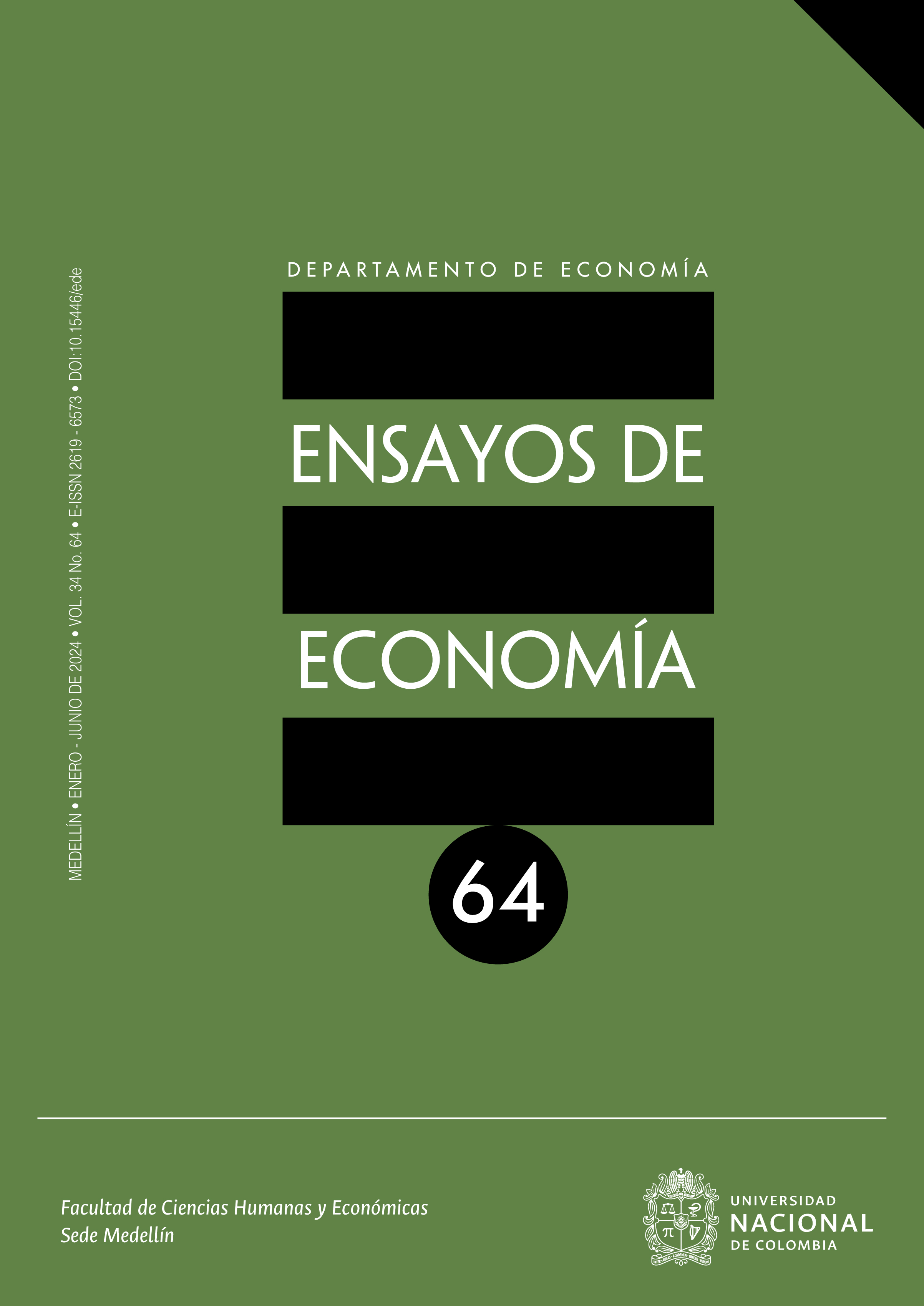Revisión de los fundamentos del desarrollo económico según Alfred Marshall: rendimientos crecientes a escala, competencia y demanda efectiva
Review of the foundations of economic development according to Alfred Marshall: increasing returns to scale, competition and effective demand
DOI:
https://doi.org/10.15446/ede.v34n64.90830Palabras clave:
desarrollo económico, Alfred Marshall, rendimientos crecientes a escala, demanda efectiva, condiciones competitivas, distribución (es)economic development, Alfred Marshall, increasing returns to scale, effective demand, competitive conditions, distribution (en)
Descargas
A fin de explorar la consistencia teórica del concepto de desarrollo económico de Alfred Marshall, se revista aquí el estado del arte sobre categorías centrales para su fundamentación. En este sentido, se presentan discusiones sobre tres nociones principales: los rendimientos crecientes a escala, las condiciones competitivas y el principio de la demanda efectiva. Ello implica considerar, primero, la perspectiva microeconómica sobre la teoría del valor bajo el equilibrio estático en condiciones competitivas con rendimientos crecientes a escala; segundo, la perspectiva macroeconómica, sustentada en el principio de la demanda efectiva, así como la vinculación entre ambas dimensiones de análisis con la temática central de la distribución del ingreso. Estas nociones teóricas fundamentan la concepción del desarrollo económico del autor, así como, más precisamente, la política económica de estímulo a la inserción industrial en el comercio exterior, a fin de proveer empleo estable en un contexto de acelerados cambios en la técnica y la demanda, y la mejora del salario real asociada al incremento de la productividad y la distribución progresiva del ingreso.
In order to explore the theoretical consistency of Alfred Marshall’s concept of economic development, this article reviews the state of the art concerning the principal categories underlying its foundations. From this perspective, it presents debates about three principal concepts: increasing returns to scale, competitive conditions, and the principle of effective demand. This involves considering: first, the microeconomic dimension of the theory of value under static equilibrium in conditions of competition with increasing returns to scale; second, the macroeconomic dimension, based on the principle of effective demand; as well as the link between these two dimensions and the central problematic of income distribution. These theoretical notions support Marshall’s understanding of the development and, more precisely, the policies of stimulating industrial insertion into foreign trade oriented to providing stable employment in a context of accelerated changes in technique and demand, and improvements in real wages associated with increased productivity, as well with the progressive distribution of income.
Referencias
Boundi Chraki, F. (2014). Relaciones de producción y conflicto capital-trabajo en la economía política. Barataria. Revista Castellano-Manchega de Ciencias Sociales, 18, 81-96. https://doi.org/10.20932/rbcs.v0i18.45 DOI: https://doi.org/10.20932/barataria.v0i18.45
Boundi Chraki, F. (2018). Valor y dinero en Marx. Revista de Economía Institucional, 20(38), 97-127. https://doi.org/10.18601/01245996.v20n38.05. DOI: https://doi.org/10.18601/01245996.v20n38.05
Bowman, R. S. (2006). Population and Policy in Marshall´s Economics. Journal of the History of Economic Thought, 28(2), 199-219. https://doi.org/10.1080/10427710600676504 DOI: https://doi.org/10.1080/10427710600676504
Caldari, K. (2015). Marshall and Complexity: A Necessary Balance between Process and Order. Cambridge Journal of Economics, 39(4), 1071-1085. https://doi.org/10.1093/cje/bev032 DOI: https://doi.org/10.1093/cje/bev032
Caravale, G. A. (1991). On the Role of Demand in Ricardo and Marshall. Journal of the History of Economic Thought, 13(2), 175-183. https://doi.org/10.1017/S1053837200003552 DOI: https://doi.org/10.1017/S1053837200003552
Chamberlin, E. H. (1948). Proportionality, Divisibility and Economies of Scale. The Quarterly Journal of Economics, 62(2), 229–262. https://doi.org/10.2307/1883221 DOI: https://doi.org/10.2307/1883221
Chumbita, J. S. (2020). Alfred Marshall, autor del siglo XX: desempleo involuntario, monopolio, amortización acelerada, competencia por nuevos productos e intervención estatal orientada a alcanzar el producto máximo. Ensayos de Economía, 30(57), 14-37. https://doi.org/10.15446/ede.v30n57.91306 DOI: https://doi.org/10.15446/ede.v30n57.91306
Clapham, J. H. (1922). Of Empty Economic Boxes. The Economic Journal, 32(127), 305-314. https://doi.org/10.2307/2222943 DOI: https://doi.org/10.2307/2222943
Contreras Herrada, T., Mendieta Muñoz, I., & Huerta Quintanilla, R. (2012). Equilibrio parcial y general: dos problemas inquietantes. Ensayos de Economía, 22(41), 89-107. https://revistas.unal.edu.co/index.php/ede/article/view/35872
De Vroey, M. (1999). Equilibrium and Disequilibrium in Economic Theory. A Confrontation of the Classical, Marshallian and Walras-Hicksian Conceptions. Economics and Philosophy, 15, 161-185. https://doi.org/10.1017/S0266267100003965 DOI: https://doi.org/10.1017/S0266267100003965
Donzelli, F. (2008). Marshall vs. Walras on Equilibrium and Disequilibrium. History of Economics Review, 48(1), 1-38. https://doi.org/10.1080/18386318.2008.11682129 DOI: https://doi.org/10.1080/18386318.2008.11682129
Dzionek-Kozlowska, J. (2015). Alfred Marshall´s Puzzles. Between Economics as a Positive Science and Economic Chivalry [Lodz Economics Working Papers No. 5]. University of Lodz http://hdl.handle.net/11089/11759
Garegnani, P. (1983). The Classical Theory of Wages and the Role of Demand Schedules in the Determination of Relative Prices. American Economic Review, 73(2), 309-313. https://www.jstor.org/stable/1816860
Garegnani, P. (1984). Value and Distribution in the Classical Economists and Marx. Oxford Economic Papers, 36(2), 291-325. https://doi.org/10.1093/oxfordjournals.oep.a041640 DOI: https://doi.org/10.1093/oxfordjournals.oep.a041640
Hague, D. (1958). Alfred Marshall and the Competitive Firm. The Economic Journal, 68(272), 673-690. https://doi.org/10.2307/2227279 DOI: https://doi.org/10.2307/2227279
Harrod, R. (1930). Notes on Supply. The Economic Journal, 40(158), 232-241. https://doi.org/10.2307/2223934 DOI: https://doi.org/10.2307/2223934
Harrod, R. (1931). The Law of Decreasing Costs. The Economic Journal, 41(164), 566-576. https://doi.org/10.2307/2223981 DOI: https://doi.org/10.2307/2223981
Hart, N. (2003). Marshall’s Dilemma: Equilibrium versus Evolution. Journal of Economic Issues, 37(4), 1139-1160. https://doi.org/10.1080/00213624.2003.11506646 DOI: https://doi.org/10.1080/00213624.2003.11506646
Kaldor, N. (1972). The Irrelevance of Equilibrium Economics. Economic Journal, 82(328), 1237-1255. https://doi.org/10.2307/2231304 DOI: https://doi.org/10.2307/2231304
Kaldor, N. (1980). The Determinateness of Static Equilibrium. En N. Karldor (comp.), Essays on Value and Distribution (pp. 13-33). Duckworth.
Keynes, J. M. (1924). Alfred Marshall, 1842-1924. Economic Journal, 34(135), 311-372. https://doi.org/10.2307/2222645 DOI: https://doi.org/10.2307/2222645
Keynes, J. M. (2012). Teoría general de la ocupación, el interés y el dinero Fondo de Cultura Económica (original publicado en 1936).
Levine, A. L. (1980). Increasing Returns, the Competitive Model and the Enigma That Was Alfred Marshall. Scottish Journal of Political Economy 27(3), 260-275. https://doi.org/10.1111/j.1467-9485.1980.tb00931.x DOI: https://doi.org/10.1111/j.1467-9485.1980.tb00931.x
Lipsey, R. (1980). An Introduction to Positive Economics. Weidenfeld & Nicolson.
List, F. (1944). Sistema nacional de economía política. Aguilar: Madrid (original publicado en 1841).
Loasby, B. J. (1978). Whatever Happened to Marshall’s Theory of Value. Scottish Journal of Political Economy, 25(1), 1-12. https://doi.org/10.1111/j.1467-9485.1978.tb01181.x DOI: https://doi.org/10.1111/j.1467-9485.1978.tb01181.x
Marshall, A. (1892). Poor-Law Reform. The Economic Journal, 2(6), 371–379. https://doi.org/10.2307/2956173 DOI: https://doi.org/10.2307/2956173
Marshall, A. (1919). Industry and Trade. A Study of Industrial Technique and Businnes and Organization; and of Their Influences on the Condition of Various Classes and Nations. Macmillan.
Marshall, A. (1925a). The Future of Working Classes. En A. C. Pigou (ed.), Memorials of Alfred Marshall (pp. 101-118). Macmillan.
Marshall, A. (1925b). A Fair Rate of Wages. En A. C. Pigou (ed.), Memorials of Alfred Marshall (pp. 212-226). Macmillan.
Marshall, A. (1925c). Mechanical and Biological Analogies. En A. C. Pigou (ed.), Economics. in Memorials of Alfred Marshall (pp. 312-318). Macmillan.
Marshall, A. (1929). Money, Credit & Commerce. Macmillan (original publicado en 1923).
Marshall, A. (2011). Principles of Economics, 8th Edition. Liberty Fund (original publicado en 1890).
Martins, N. O. (2013). Sraffa, Marshall and the Principle of Continuity. Cambridge Journal of Economics, 37(2), 443-462. https://doi.org/10.1093/cje/bes070 DOI: https://doi.org/10.1093/cje/bes070
McWilliams Tullberg, R. (1992). Alfred Marshall´s Attitude toward the Economics of Industry. Journal of the History of Economic Thought, 14 (2), 257-270. https://doi.org/10.1017/S1053837200005034 DOI: https://doi.org/10.1017/S1053837200005034
Mongiovi, G. (1990). Notes on Say’s Law, Classical Economics and the Theory of Effective Demand. Contributions to Political Economy, 9(1), 69-82. https://doi.org/10.1093/oxfordjournals.cpe.a035755 DOI: https://doi.org/10.1093/oxfordjournals.cpe.a035755
Mongiovi, G. (1996). Sraffa’s Critique of Marshall: A Reassessment. Cambridge Journal of Economics, 20(2), 207-224. DOI: 10.1093/oxfordjournals.cje.a013613 DOI: https://doi.org/10.1093/oxfordjournals.cje.a013613
Newman, P. (1960). The Erosion of Marshall’s Theory of Value. The Quarterly Journal of Economics, 74(4), 587-599. https://doi.org/10.2307/1884353 DOI: https://doi.org/10.2307/1884353
Panico, C., & Salvadori, N. (1994). Sraffa, Marshall and the Problem of Returns. The European Journal of the History of Economic Thought, 1(2), 323-343. https://doi.org/10.1080/10427719400000005 DOI: https://doi.org/10.1080/10427719400000005
Panico, C. (1991). Some Notes on Marshallian Supply Functions. The Economic Journal, 101(406), 557-569. https://doi.org/10.2307/2233559 DOI: https://doi.org/10.2307/2233559
Pasinetti, L. (1978). Crecimiento económico y distribución de la renta. Ensayos de teoría económica. Alianza Editorial.
Pigou, A. C. (1927). The Laws of Diminishing and Increasing Cost. The Economic Journal, 37(146), 188–197. https://doi.org/10.2307/2224353 DOI: https://doi.org/10.2307/2224353
Pigou, A. C. (1928). An Analysis of Supply. The Economic Journal, 38(150), 238-257. https://doi.org/10.2307/2223864 DOI: https://doi.org/10.2307/2223864
Pigou, A. C. (1969). Alfred Marshall y el pensamiento actual (Trad. Martín A. Fuchs). Buenos Aires: Juárez editor (original publicado en 1953).
Prendergast, R. (1992). Increasing Returns and Competitive Equilibrium –the Content and Development of Marshall’s Theory. Cambridge Journal of Economics, 16(4), 447-462. https://www.jstor.org/stable/23599626
Raffaelli, T. (2001). Marshall on Mind and Society: Neurophysiological Models Applied to Industrial and Business Organization. The European Journal of the History of Economic Thought, 8(2), 208-229. https://doi.org/10.1080/09672560110039290 DOI: https://doi.org/10.1080/09672560110039290
Raffaelli, T. (2004). Whatever Happened to Marshall’s Industrial Economics? The European Journal of the History of Economic Thought, 11(2), 209-229. https://doi.org/10.1080/0967256042000209251 DOI: https://doi.org/10.1080/0967256042000209251
Raffaelli, T., Beccattini, G., & Dardi, M. (2006). The Elgar Companion to Alfred Marshall. Edward Elgar. DOI: https://doi.org/10.4337/9781035304820
Robbins, L. (1928). The Representative Firm. The Economic Journal, 38(151), 387-404. https://doi.org/10.2307/2224316 DOI: https://doi.org/10.2307/2224316
Robertson, D. H., Sraffa, P. & Shove, F. (1930). Increasing Returns and the Representative Firm. The Economic Journal, 40(157), 79-116. https://doi.org/10.2307/2223643 DOI: https://doi.org/10.2307/2223643
Robinson, J. (1934). What is Perfect Competition? The Quarterly Journal of Economics, 49(1), 104-120. https://doi.otg/10.2307/1883878 DOI: https://doi.org/10.2307/1883878
Rosselli, A. (2005). Sraffa and the Marshallian tradition. The European Journal of the History of Economic Thought, 12(3), 403-423. https://doi.org/10.1080/09672560500239976 DOI: https://doi.org/10.1080/09672560500239976
Samuelson, P. (1967). The Monopolist Competition Revolution. En R. E. Kuenne (ed.), Monopolistic Competition Theory: Studies in Impact – Essays in Honor of E. H. Chamberlin (pp. 412-445). Wiley and Sons.
Samuelson, P. (1987). Sraffian Economics. The New Palgrave Dictionary of Economics. Macmillan. DOI: https://doi.org/10.1057/978-1-349-95121-5_1667-1
Samuelson, P. (1991). Sraffa’s Other Leg. The Economic Journal, 101(406), 570-574. https://doi.org/10.2307/2233560 DOI: https://doi.org/10.2307/2233560
Schumpeter, J. A. (1928). The Instability of Capitalism. The Economic Journal, 38(151), 361-386. https://doi.org/10.2307/2224315 DOI: https://doi.org/10.2307/2224315
Schumpeter, J. A. (2003a). Capitalism, Socialism and Democracy. Routledge (original publicado en 1943).
Schumpeter, J. A. (2003b). Ten Great Economists: From Marx to Keynes. Routledge (original publicado en 1952).
Shove, G. F. (1942). The Place of Marshall’s Principles in the Development of Economic Theory. The Economic Journal, 52(208), 294-329. https://doi.org/10.2307/2226235 DOI: https://doi.org/10.2307/2226235
Souter, R. W. (1933). The Nature and Significance of Economic Science. Quarterly Journal of Economics, 47(3), 377-413. https://doi.org/10.2307/1883978 DOI: https://doi.org/10.2307/1883978
Sraffa, P. (1925). Sulle relazioni fra costo e quantità prodotta. Annali di Economia, 2(1), 277-328. https://scholar.google.com.ec/citations?view_op=view_citation&hl=es&user=qYpd7LAAAAAJ&cstart=100&pagesize=100&sortby=pubdate&citation_for_view=qYpd7LAAAAAJ:9yKSN-GCB0IC
Sraffa, P. (1926). The Laws of Returns under Competitive Conditions. The Economic Journal, 36(144), 535-550. https://doi.org/10.2307/2959866 DOI: https://doi.org/10.2307/2959866
Sraffa, P. (1930). An Alleged Correction of Riccardo. The Quarterly Journal of Economics, 44(3), 539-544. DOI: https://doi.org/10.2307/1885795
Sraffa, P. (1960). Production of Commodities by Means of Commodities. Cambridge University Press.
Trezzini, A. (2020). Sraffa on Marshall’s Theory of Value in the Cambridge Lectures: Achievements in an Unfinished Criticism. The European Journal of the History of Economic Thought, 1-23. https://doi.org/10.1080/09672567.2020.1776356 DOI: https://doi.org/10.1080/09672567.2020.1776356
Viner, J. (1931). Cost Curves and Supply Curves. Zeitschrift für National-ökonomie, 3, 23-46. https://doi.org/10.1007/BF01316299 DOI: https://doi.org/10.1007/BF01316299
Wicksell, K. (1977). Lectures on Political Economy. Volume 1: General Theory. A. M. Kelley (original publicado en 1934). DOI: https://doi.org/10.4324/9780203835579-1
Wicksell, K. (1978). Lectures on Political Economy. Volume 2: Money. A. M. Kelley (orifinal publicado en 1935). DOI: https://doi.org/10.2307/2548682
Winch, D. (2008). Review Essay: Marshall Revived. Journal of the History of Economic Though, 30(1), 127-134. https://doi.org/10.1017/S1042771608000112 DOI: https://doi.org/10.1017/S1042771608000112
Young, A. (1928). Increasing Returns and Economic Progress. The Economic Journal, 38(152), 527-542. https://doi.org/10.2307/2224097 DOI: https://doi.org/10.2307/2224097
Cómo citar
APA
ACM
ACS
ABNT
Chicago
Harvard
IEEE
MLA
Turabian
Vancouver
Descargar cita
Licencia

Esta obra está bajo una licencia internacional Creative Commons Atribución-NoComercial-SinDerivadas 4.0.
Se autoriza la reproducción sin ánimo de lucro de los materiales, citando la fuente.





























